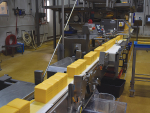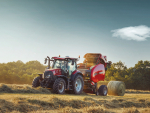Melbourne University professor Mike Goddard picked up his US National Academy of Sciences medal in April amid indications that his work on genomic selection in dairy cattle might also lead to benefits for human health.
Goddard also has advice for dairy farmers who may still be relying on visual appraisal only of dairy cattle: it is largely a waste of time, promoting skinny cows with poor fertility.
He wants all breeders to work with the Australian Dairy Herd Information Service (ADHIS) and urges them to upgrade the way they upload their data to ADHIS to help progress on fertility.
Goddard also says the hybrid vigour produced by cross-breeding is the closest thing farmers will ever get to a free lunch. The hybrid off-spring can then be crossed back with either parent breed, and "you are always ahead".
Goddard apologised before he answered a question about the visual appraisals used in classification and show rings.
"Sorry to be impolite," he said. "But it's largely a waste of time"We've got ourselves into a few misleading situations. For example, a long time ago, before we knew how much milk each cow gave, a cow that was not too fat – in fact positively skinny – was probably giving more milk than a cow that was fat. A preference for skinny cows developed.
"But when you know how much milk the cow gives, there's absolutely no benefit in selecting for skinny cows. But people have continued to select for skinny cows – calling it dairy character or angularity – as well as selecting for milk yield.
"What that has done is decreased fertility, and decreased hardiness. Because one reason a cow is skinny is that there is something wrong with her. And the cows that are really skinny don't cycle and don't get pregnant.
"This traditional philosophy of selecting for dairy character should have been abandoned years ago as soon as we started measuring milk yield."
Goddard grew up in Melbourne where he studied to be a vet. He worked on the genetics of guide dogs and tropical beef cattle before specialising in dairy genetics.
He said genomic selection uses DNA markers all over all the chromosomes to identify a trait. Previous practice had looked for a couple of markers you hoped would work.
In 2000, Goddard began work with Norwegian visiting scientist Theo Meuwissen on simulations of an entire dairy cow genome. He remembers Meuwissen coming to him with results showing their simulations were achieving high accuracies.
They published a paper in Genetics in 2001 with another Melbourne scientist Ben Hayes, who now heads the dairy cattle genetics program at the Dairy Futures CRC. This paper is now seen as the foundation of genomics.
The 2005 roll out of the SNP chips which can efficiently assay the single nucleotide polymorphisms in DNA then enabled practical application of the work.
The US National Academy of Science's biannual John J. Carty Award recognises distinguished accomplishments in science. In 2016, its medals and $25,000 prize are for agricultural science.
The academy says that the principles of genomic selection come from the landmark paper by Goddard, Meuwissen and Hayes.
"The trio showed that it should be possible to identify individuals with high genetic value by using thousands of molecular genetic markers covering the entire genome," the academy notes.
"Genomic selection first became widely adopted in the dairy cattle industry where breeders found that they could identify bulls with high genetic value early in life, rather than waiting years to see if they produced offspring with required traits, saving much time and money.
"Genomic selection has now been applied to other animal species, such as pigs and poultry, and to plants such as cotton, rice and wheat.
"And the concepts behind genomic selection have even proved useful in the field of human genetics and the search for predictors of disease."
Goddard says a third of dairy inseminations in Australian still use straws from genomically-tested bulls.
















